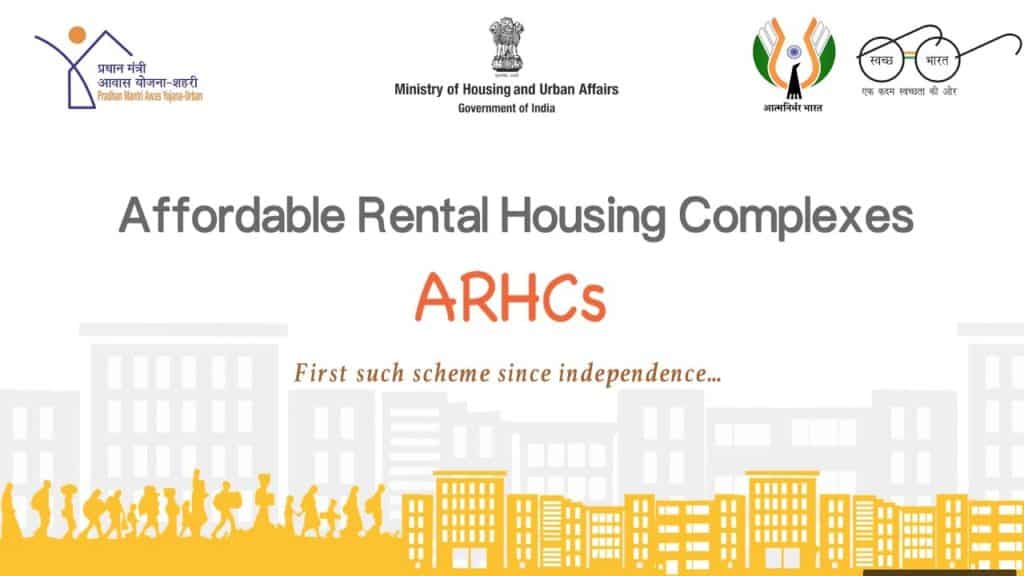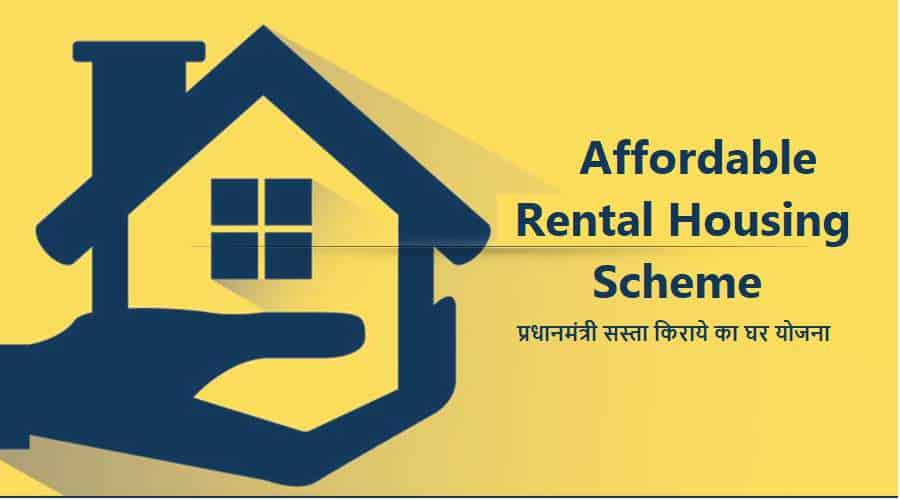
In India, most urban migrants are observed to stay put in either the slums, informal settlements, or unauthorized colonies, with the sole purpose of saving up on the rental costs. In addition to their stay, these migrants happen to spend a substantial amount of time commuting to their workplaces on foot or using cycling to further reduce the cost of travel expenses.
Noticing the hardship, the Government of India wanted to improve their productivity and ease their living, they then promoted rental housing for urban migrant’s poor conditions, and make them feel inclusive rather than outcasts.
As a result of which, the Urban Indian Affairs & the Ministry of Housing initiated ARHCs or the Affordable Rental Housing Complexes as a sub-scheme of the PMAY-U or the Pradhan Mantri Awas Yojana – Urban. As a part of this housing and urban affairs, the main objective was to offer comfortable living and planned/dignified housing, both close to their workplaces in the industrial sector and the non-formal urban economy.
When were the housing complexes (ARHCs) for the urban dwellers announced? What are the benefits of this affordable rental housing complex? What were the models that were introduced? Let’s find the answers to these questions with the help of the article below!
Affordable Rental Scheme – When Was It Announced?

The rental housing scheme (ARHC) was announced in May 2020 as a part of the Pradhan Mantri Awas Yojana – Urban (PMAY-U) economic stimulus package, approved by the Union Cabinet on 8th July 2020.
This scheme for the urban migrants’ poor seemed like a vital step towards the vision of ‘AtmaNirbhar Bharat Abhiyan,’ giving an impetus to the broader objective of “Housing for All.”
Who Are The Target Beneficiaries Under The ARHC Scheme?
The affordable rental housing complex (ARHC) scheme was in its primary stage and was expected to benefit nearly 3 lakh urban poor and migrants of India who came from the EWS and LIG categories. This section of the society came to the urban areas in search of better employment opportunities in villages and small towns.
These migrants include the laborers, street vendors, rickshaw pullers, and the major part of the workforce who is employed in the industrial, manufacturing, hospitality, and health care sectors. Apart from these, the long-term tourists, visitors, and students could also fall into the same category under the scheme.
What Are The Strives To Help Build A New Ecosystem Including The Urban Poor And Migrants?

According to the operational guidelines of the affordable rental housing scheme, an ARHC is a list that includes about 40 dwelling units and dormitories with a few basic facilities of civic infrastructure. These facilities include – water, sanitation, sewage/septage, road, electricity, and necessary social/commercial infrastructure for urban migrants of the economically weaker sections (EWS) / low-income group (LIG) categories.
As a part of the pro-poor measure, the government of India intends to formulate a sustainable ecosystem for urban migrants poor wherein they could get accommodations that are rented at a nominal rate. By doing so, the Governments intend to provide them with a quality life standard and minimize the unnecessary work-related travel, under the ARHC scheme.
As a result, it would inculcate a sense of security and encourage the migrants to migrate to their home towns in a crisis, such as the current COVID-19 pandemic.
What Are The Two Implementation Models Of ARHCs?
The Government of India intends to implement the rental housing scheme across the statutory towns, notified planning areas, development authorities, industrial development authorities, and/or any other area that is notified by the State / UT Government.
All of these projects that fall under the ARHC scheme are planned to be utilized exclusively for rental housing for a minimum period of 25 years. For which, the government has outlined two models as explained below:
1) Model-1 Of Affordable Housing Scheme ARHC
On the surface, model -1 of the affordable rental housing complex aims to convert all existing government-funded vacant houses into ARHCs through public-private partnerships (PPP) and/or via public agencies.
As per the present count, about 1.2 lakh houses are completed, non-allotted, and government-funded across cities. These various former and existing housing schemes mostly fall under the Jawaharlal Nehru National Urban Renewal Mission (JNNURM), Rajiv Awas Yojana (RAY), PMAY-U, and state-run housing schemes.
Here, the completed housing units are planned to be converted into rental housing complexes through concession agreements for a period of 25 years. The concessionaires via transport bidding will be selected by the states/union territories. The selected concessionaires then will be responsible to make the complexes liveable by repairing, maintaining the buildings, fixing infrastructure such as the water, sewer, sanitation, road, commercial facilities – health centers, community centers, ATMs, etc.
Note – After completing 25 years, these housing complexes would be transferred to Urban Local Bodies who would then restart the next cycle by following the same pattern or make their own.
2) Model-2 Of Affordable Housing Scheme ARHC
This model includes the construction, operation, and maintenance of the rental housing complexes ARHC by public/private entities on available vacant land.
Here, as opposed to model-1, the government encourages the private and public entities to develop affordable rental housing on their own available unused land, offering special incentives and benefits. These private entities include industries, trade associations, manufacturing companies, educational and health institutions that have a large portion of unutilized vacant land.
As mentioned above, these entities will be responsible to construct, operate and maintain ARHCs on their vacant land for 25 years. They can also provide accommodation to their workers/laborers who serve the requirement of neighboring entities.
The incentives to promote the development of such housing complexes include concessional project financing, permission changes, 50% additional Floor Area Ratio (FAR), or Floor Space Index (FSI) free of cost, income tax & GST exemptions on profit and gains from ARHCs, technology innovation grant or TIG for innovative technology, single-window clearance (30 days), concessional loan at priority sector lending rates and tax reliefs with affordable housing, etc.
Note – The government is considering an initially estimated expenditure of INR 600 crore as a part of the technology innovation grant that will be released for projects who use these identified innovative technologies for construction.
To Conclude: The Highlights Of The Affordable Renting Housing Complexes, ARHCs?
As we can study, successful implementation of the affordable rental housing complex would help boost the living standards of the migrant workers and urban poor while uplifting their lifestyle. Adding to which, listed below are a few other benefits/highlights that an individual can look forward to:
- Affordable rental housing complexes ARHC will help the migrants have decent accommodation in the urban areas at an affordable rent that would also be close to their workplaces
- The scheme intends to empower the EWS and LIG segments, by helping them feel secure and also prepare the section of the society’s “new normal” as understood with respect to the times of COVID-19
- Would ensure sustained supply of human resources for industries and manufacturing units
- The affordable rental housing complexes enable productivity of the vacant government-funded houses
- They propel new investments and drive the creation of future jobs in the rental housing sector.
- The ARHC incentivizes the private and public sectors to develop affordable rental housing on their own vacant land
- Prevent the future growth of the unplanned slums in India
Affordable Rental Housing FAQs:
1. What is the affordable housing scheme?
Affordable rental housing is a housing scheme that is deemed affordable to a median household income, rated below as the national government or a local government recognized by the housing affordability index. On the other hand, a housing choice is a response to a complex set of economic, social, and psychological impulses.
2. Who will implement the ARHC?
The affordable rental housing scheme will be implemented via two models: (1) By utilizing the existing Government funded vacant houses into ARHCs with the help of the Public-Private Partnership (PPP) and/or by Public Agencies, and (2) By the construction, operation, and maintenance of ARHCs by Public/ Private entities on their vacant land.
3. What is an affordable housing scheme in India?
Pradhan Mantri Awas Yojana (PMAY) is an initiative by the Government of India. As part of this initiative, the government will provide affordable housing to the urban poor with a target of building 2 crore (20 million) affordable houses by 31 March 2022.
4. When was ARHC launched?
The Jawaharlal Nehru National urban renewal mission and Rajiv Awas Yojana launched in the year 2005 and worked till 2014. They aimed to provide pucca houses to the slum dwellers based on ownership.






